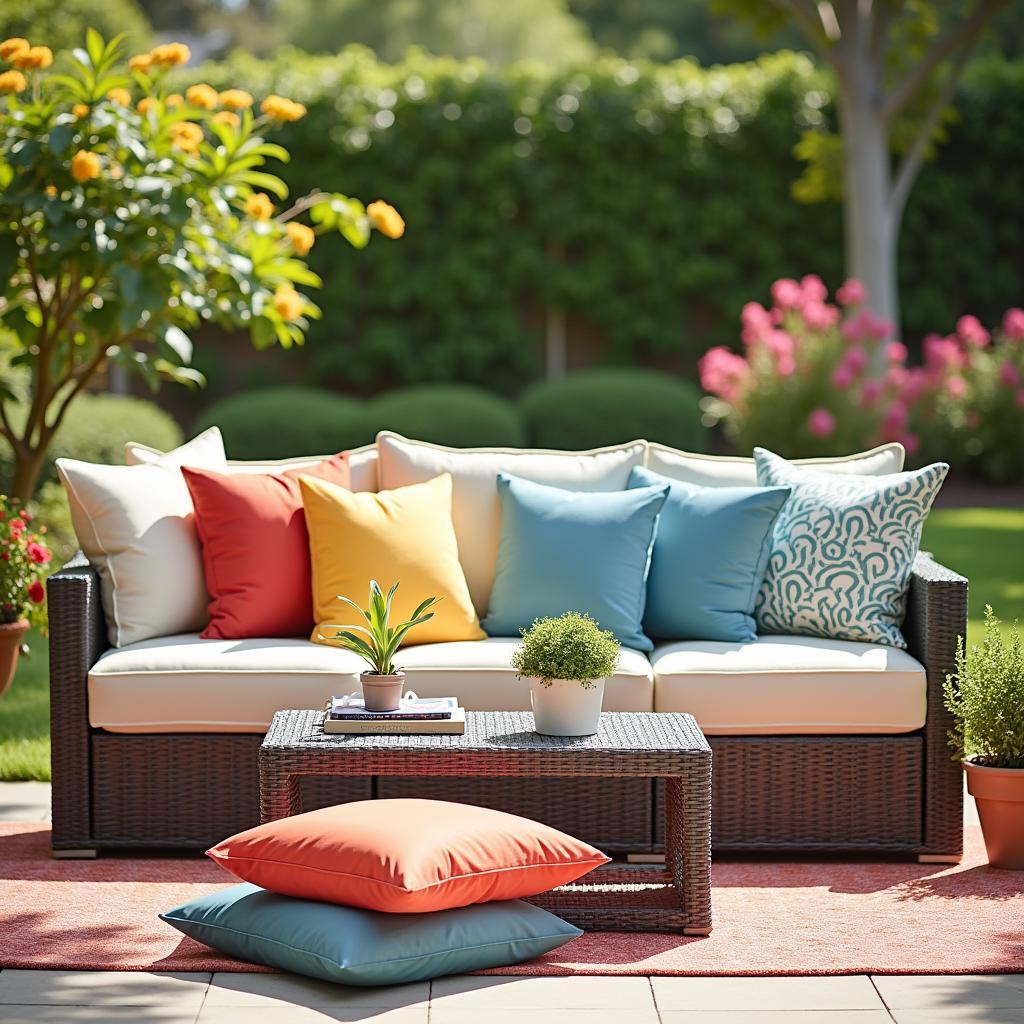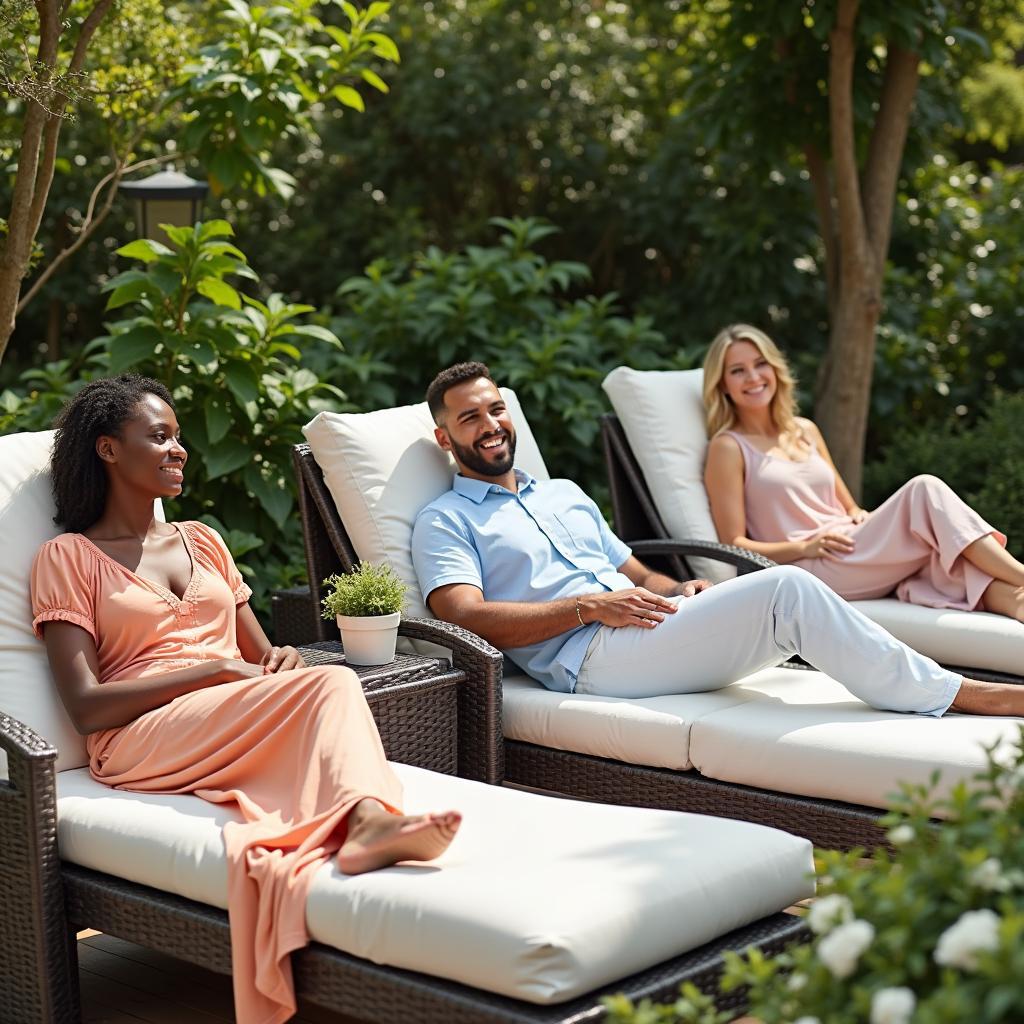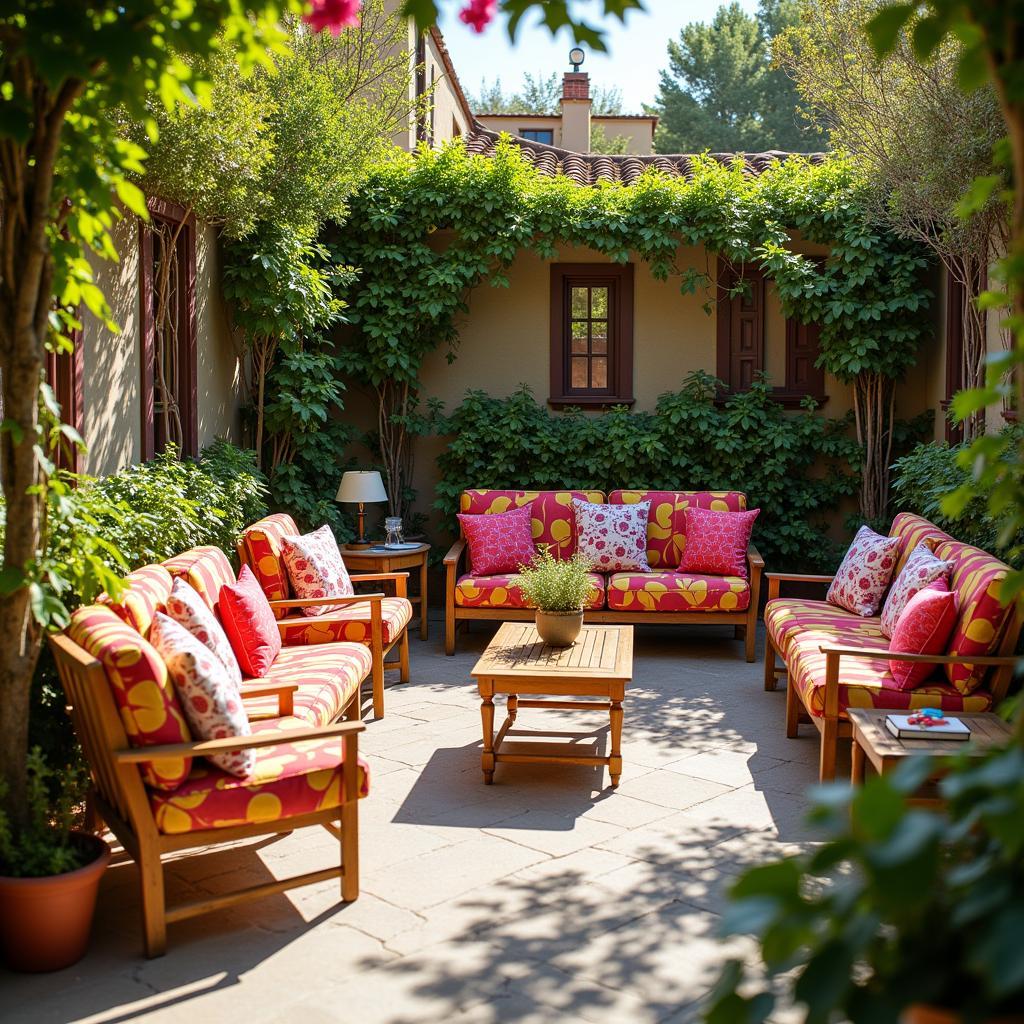Introduction
Outdoor furniture cushions are essential for enhancing the comfort and aesthetics of your outdoor spaces. They provide the necessary support for enjoying leisurely hours on the patio or in the garden. However, one common concern is whether these cushions can withstand exposure to moisture.
Moisture can be a significant issue, potentially leading to sogginess, mold, and mildew if not managed properly. This raises questions about whether outdoor furniture cushions are truly waterproof. Understanding the difference between waterproof and water-resistant materials is crucial when selecting the right cushions for your needs.
Waterproof vs. Water-Resistant Cushions
- Waterproof Cushions: Designed to completely prevent water penetration, often using plastic coatings.
- Water-Resistant Cushions: Capable of repelling water to some extent but may absorb moisture over extended exposure.
Understanding these distinctions helps in making informed decisions and choosing cushions that provide both durability and comfort.
Understanding Outdoor Furniture Cushions
Outdoor cushions are an essential part of patio furniture, providing comfort and style to outdoor living spaces. When choosing cushions, it’s important to know the different types of outdoor cushions available. Here are some common types:
- Chair cushions: Specifically designed for outdoor chairs, offering support and comfort.
- Bench cushions: Perfect for larger seating areas such as garden benches.
- Lounger cushions: Designed for sun loungers, these provide full-body comfort while basking in the sun.
The materials used in these outdoor cushions play a significant role in their durability and performance. Some commonly used materials include:
- Polyester: Known for its durability and resistance to stretching and shrinking.
- Acrylic: Offers vibrant colors that resist fading from sunlight.
- Olefin: Highly resistant to moisture and chemicals, making it ideal for outdoor use.
When selecting the best fabric for your outdoor cushions, it’s crucial to consider factors such as durability, maintenance, and weather resistance. You can find helpful tips on how to choose the best outdoor fabric for cushions here.
Moisture resistance varies significantly among products. Some cushions feature water-resistant fabrics that can handle light rain but might still absorb water if exposed over time. Others come with waterproof materials that prevent any water penetration, often at the cost of breathability. The choice between these depends on your specific needs and environmental conditions, highlighting the importance of informed decision-making when selecting outdoor furniture cushions.
Types of Moisture Resistance in Outdoor Furniture Cushions

Understanding the different types of moisture resistance is crucial when selecting outdoor furniture cushions. Here’s what you need to know:
Waterproof Cushions
Definition:
Waterproof cushions are designed to completely block water from penetrating the fabric. They typically feature a plastic coating on the underside, acting as a barrier against moisture.
Characteristics:
- Prevents water from soaking through, ideal for heavy rain.
- Often more durable due to robust materials.
- The plastic coating can reduce breathability, potentially causing discomfort in warm weather.
- These cushions can even repel stains, making them easier to maintain.
Water-Resistant Cushions
Definition:
Water-resistant cushions are designed to resist light rain and moisture but may not withstand prolonged exposure to water.
Characteristics:
- Suitable for areas with occasional splashes or light showers.
- Often more comfortable than waterproof options due to better airflow.
- May absorb some moisture, requiring time to dry out after exposure.
- It’s important to note that outdoor cushions can get wet, so proper care is essential.
Water-Repellent Fabrics
Explanation:
Water-repellent fabrics offer a middle ground between waterproof and water-resistant options. These fabrics allow liquids to bead up and run off rather than being absorbed.
Characteristics:
- Allows air circulation, enhancing comfort for users.
- Keeps interiors dry by preventing absorption.
- Often incorporate advanced fabric treatments that enhance performance without compromising comfort, similar to different fabrics used for outdoor applications.
Choosing the right type of cushion depends on your specific needs and climate conditions. Each option offers distinct benefits, catering to various preferences and outdoor environments.
The Science Behind Waterproofing Outdoor Furniture Cushions
Plastic Coatings and Waterproofing
Waterproof cushions often use a plastic coating to keep moisture out of the fabric. This coating is usually applied to the underside of the cushion material, creating a barrier that prevents water from seeping through. This technology ensures that while the outside may get wet, the inner filling stays dry, making the cushion last longer.
Impact on Breathability and Comfort
The downside of such effective waterproofing is its impact on breathability. Plastic coatings tend to trap air and moisture, which can make cushions feel hot and sticky during use. Lack of airflow might lead to discomfort, especially in warmer climates where outdoor seating is desired for relaxation.
Balancing Protection and Comfort
Designers strive to strike a balance between protection and comfort when creating outdoor furniture cushions. The challenge lies in achieving effective moisture management without sacrificing user comfort. Some manufacturers are exploring innovative solutions like perforated plastic layers or hybrid materials that offer partial breathability while still providing adequate protection against water.
Understanding whether outdoor furniture cushions are waterproof involves considering these factors. While plastic coatings offer excellent protection, they come at a cost to comfort, prompting many to seek alternatives that provide both durability and usability in diverse weather conditions.
Water-Repellant Fabrics for Outdoor Use
Water-repellent fabrics are a better choice than traditional waterproof options for outdoor furniture cushions. Unlike fully waterproof materials that can be uncomfortable due to limited air flow, water-repellent fabrics provide both protection and breathability. This type of fabric allows air to circulate, keeping the seating area cooler and more comfortable.
Advantages of Water-Repellent Fabrics
- Breathability: Better air flow prevents heat and moisture from building up, ensuring user comfort.
- Lightweight: Usually lighter than waterproof materials, making cushions easier to handle and move.
- Aesthetic Appeal: Typically available in a wide range of colors and textures, allowing for more design flexibility.
How Water-Repellent Fabrics Work
The innovation behind water-repellent fabrics lies in their ability to cause liquids to bead up and roll off the surface. This is achieved through:
- Surface Tension Enhancement: Special coatings increase the fabric’s surface tension, causing water droplets to form beads rather than soaking in.
- Angle of Contact: Adjustments in the fabric weave create an angle that promotes run-off.
Recent Innovations in Fabric Technology
Recent advancements have led to significant improvements in fabric technology:
- Nano-coatings: These ultra-thin layers enhance water repellency without affecting texture or color.
- Hybrid Materials: Combining synthetic fibers with natural ones results in fabrics that excel in both durability and comfort.
These developments ensure that your outdoor furniture cushions remain dry while providing an inviting place to relax.
As you consider the waterproofing of outdoor furniture cushions, it’s also important to think about how covers can enhance their longevity. For more information on protecting your outdoor furniture investments, check out our article on whether outdoor furniture covers are worth it.
Cushion Fillings and Their Impact on Performance in Outdoor Furniture Cushions

Choosing the right cushion filling materials is crucial for ensuring the longevity and comfort of outdoor furniture cushions. Two popular types of fillings include foam and polyester, each offering distinct benefits.
Foam Fillings
Known for their durability and support, foam fillings can vary in density to provide different levels of comfort. However, traditional foam can absorb moisture, potentially leading to sogginess if not designed specifically for outdoor use.
Polyester Fillings
Often used due to their lightweight and quick-drying properties. Polyester is a favored choice when moisture resistance is a priority. Some polyester fillings are treated to enhance water repellency, making them suitable for wet environments.
The importance of non-absorbent fillings cannot be overstated. These materials help prevent sogginess by resisting water absorption, ensuring that your cushions remain comfortable even after exposure to rain or spills. Non-absorbent fillings also play a critical role in mold prevention, as they dry more rapidly compared to absorbent alternatives.
When selecting high-quality fillings, consider these tips:
- Look for fillings labeled as “quick-dry” or “water-resistant.”
- Opt for materials with anti-microbial treatments to combat mold and mildew growth.
- Check product specifications to ensure compatibility with your climate and usage needs.
Paying attention to these aspects will help you maintain the functionality and appearance of your outdoor furniture cushions over time.
Choosing the Right Outdoor Cushion for Your Needs
Selecting the perfect outdoor cushion involves several key considerations. Begin by evaluating the material type—options like polyester and acrylic are popular for their durability and moisture resistance. Consider the intended use; frequent exposure to rain might necessitate more robust water-repellent fabrics, whereas cushions used in covered patios can afford less moisture protection.
If you’re leaning towards waterproof options, this complete guide on waterproof fabric could be beneficial in understanding your choices.
Recommended Products:
- Sunbrella Outdoor Cushions: Known for excellent UV protection and water resistance.
- Classic Accessories Montlake FadeSafe Patio Seat Cushion: Offers a blend of comfort and moisture resistance.
- Pillow Perfect Outdoor/Indoor Tufted Bench/Swing Cushion: Combines style with fade-resistant fabric.
When purchasing, reading labels is crucial. Look for terms such as waterproof, water-resistant, or water-repellent to understand the level of moisture protection offered. Specifications like fabric breathability and filling material should also be considered to ensure both comfort and longevity.
By focusing on these aspects, you can make an informed decision that balances comfort with durability, ensuring your outdoor furniture cushions meet your specific needs.
Final Thoughts on Waterproof vs Water-Resistant Outdoor Furniture Cushions
When asking, “Are outdoor furniture cushions waterproof?”, it’s important to know the difference between waterproof and water-resistant options:
- Waterproof cushions have plastic coatings to stop water from getting in, but they might not be as comfortable because they don’t let air through.
- Water-resistant cushions keep moisture away well and are more comfortable, but you need to be careful during heavy rain.
Choosing the right cushion means finding a balance between your outdoor needs and comfort preferences. In most cases, water-repellent fabrics are the best choice because they protect while still allowing air to flow.
FAQs (Frequently Asked Questions)
Are outdoor furniture cushions waterproof?
Not all outdoor furniture cushions are waterproof. It’s important to differentiate between waterproof and water-resistant cushions. Waterproof cushions are designed to completely block moisture, while water-resistant cushions can resist some moisture but may not be entirely impervious.
What types of materials are commonly used in outdoor cushions?
Outdoor cushions are typically made from various materials such as polyester, acrylic, and foam. These materials are chosen for their durability and ability to withstand outdoor conditions, including exposure to moisture.
What is the difference between waterproof and water-resistant cushions?
Waterproof cushions are fully sealed against moisture penetration, making them ideal for heavy rain or spills. Water-resistant cushions can repel some water but may allow moisture to seep through under certain conditions. Understanding this difference is crucial when selecting the right cushion for your needs.
How do plastic coatings contribute to the waterproofing of outdoor cushions?
Plastic coatings applied to outdoor cushions create a barrier that prevents water from penetrating the fabric. However, this can affect breathability, so it’s essential to balance waterproofing with comfort when selecting cushion designs.
What filling materials are best for preventing mold in outdoor furniture cushions?
Non-absorbent fillings such as certain types of foam or polyester are best for preventing mold and mildew in outdoor furniture cushions. These materials help avoid sogginess and maintain the integrity of the cushion over time.
What factors should I consider when choosing outdoor cushions?
When selecting outdoor cushions, consider factors such as material type, intended use, and moisture resistance. Look for products that provide a good balance of comfort and protection against the elements, and make sure to read labels carefully to understand their specifications.


